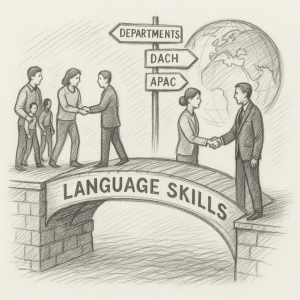As globalization, hybrid work, and talent shortages continue to reshape business priorities, the demand for multilingual communication and agile internal talent development has never been higher. Organizations face a dual challenge: fierce competition for external talent and an increasing need to retain their top performers. The traditional “hire-for-the-need” model is proving costly and unsustainable. This has led savvy leaders to a powerful conclusion: one of the most effective ways to build a resilient, skilled workforce is to look within.
Language upskilling plays a pivotal role not just in career advancement but in building a multilingual workforce prepared for cross-functional collaboration and international market expansion.
Internal mobility powered by strategic language upskilling is emerging as a cornerstone of modern talent strategy. By investing in developing the language skills of existing employees, companies are not only closing critical talent gaps but also fostering a culture of loyalty, engagement, and continuous career growth. This approach transforms employees from static assets into a dynamic internal talent pipeline, ready to meet the challenges of a global market.
Shifting from recruitment costs to retention investments
The cycle of external recruitment is demanding. It consumes significant time and financial resources, and there’s always the risk that a new hire may not be a good cultural fit. In contrast, investing in your current employees offers a compelling return:
- You build on a known quantity: these employees already understand your company culture, products, and processes.
- It boosts morale and engagement: when employees see tangible investment in their development and clear pathways for advancement, their loyalty and motivation soar.
- It’s highly cost-effective: the cost of upskilling a current employee is often significantly lower than the cost of recruiting, hiring, and onboarding a new one.
Language skills: the key that unlocks internal doors
Why are language skills such a powerful catalyst for internal mobility? Because in an increasingly interconnected world, language proficiency opens doors to new roles, responsibilities, and markets that would otherwise be inaccessible.
Imagine – an engineer with newly acquired German skills can transition to a technical sales or support role for the DACH region. A marketing specialist who learns Japanese can spearhead a new market entry campaign in Tokyo. An employee earmarked for a leadership role can be prepared for managing an international team by upskilling in the relevant language, ensuring they can communicate and lead effectively across cultures.
Language skills allow employees to participate in short-term international projects and assignments, gaining invaluable experience and broadening their horizons without the need for a full relocation.
Employees who can communicate fluently in more than one key business language become invaluable bridges between different teams, departments, and international offices, streamlining collaboration and reducing misunderstandings.
The strategic payoff of a language upskilling program
The benefits of creating a formal language development program resonate across the entire organization:
- Directly addresses skill gaps: instead of searching externally for a Spanish-speaking customer service manager, you can train a high-performing existing manager, filling the role faster and more reliably.
- Drives employee retention: in a competitive market, a clear commitment to career development is a powerful retention tool. Employees are more likely to stay with a company that invests in their future.
- Fosters a learning culture: it signals that continuous improvement is a core value, encouraging employees to be adaptable and ready for future challenges.
- Maximizes your talent ROI: you leverage the full potential of your workforce, capitalizing on their deep institutional knowledge while equipping them with new, valuable skills.
- Strengthens your employer brand: companies known for robust internal mobility and development programs become magnets for ambitious talent, both internally and externally.
How to build your internal language upskilling pipeline
Implementing a successful program requires a structured, strategic approach:
Step 1 – conduct a strategic language audit:
The crucial first step is to map your existing linguistic capabilities against your future business needs. Which markets are you expanding into? Where are your communication bottlenecks? A thorough audit identifies your most critical language gaps and opportunities.
Step 2 – identify high-potential employees:
Look for motivated individuals whose career goals align with the company’s needs. Use performance reviews and career development discussions to pinpoint employees who are eager and apt to learn.
Step 3 – offer relevant and flexible training:
Provide a mix of learning options, such as online platforms, one-on-one tutoring, or immersive language programs. Crucially, tailor the training to your business context, focusing on professional vocabulary and real-world communication scenarios.
Step 4 – create opportunities for practice:
Learning a language requires practice. Integrate opportunities for employees to use their new skills in their daily work, such as joining international meetings, handling correspondence, or working on cross-border projects.
Step 5 – recognize and reward progress:
Formally recognize language skill acquisition through certifications or internal acknowledgements. More importantly, link this new proficiency to tangible career opportunities, promotions, and new roles.
Your greatest asset is already on your payroll
In the quest for talent, the answer often lies closer than you think. By investing in language upskilling, you are not just teaching new words; you are building bridges to new markets, creating pathways for your best people, and forging a more capable, engaged, and future-proof organization. It’s a strategic investment in the talent that has already proven its commitment to you.
Quick benefits of language upskilling
- Faster internal promotions
- Greater cross-border team cohesion
- Reduced hiring lag time
- Enhanced employee engagement
- Improved customer localization efforts
Ready to unlock your team’s hidden global potential??
Take the first step by conducting a language skills audit with Focus. Discover where your internal talent can grow—and how language training can drive business results. We enable you to map your internal talent and turn language skills into your next competitive advantage.





